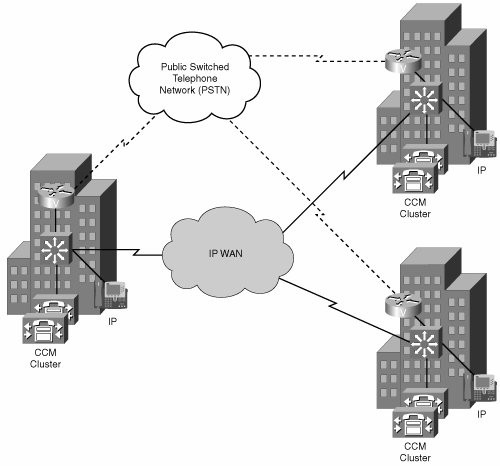Cisco Unified CallManager
| Cisco's IP Communications product line, including IP telephony, unified communication, audio/video conferencing, and customer contact applications, helps organizations realize business gains by improving operational efficiencies. These improved operational efficiencies result in increased organizational productivity and enhanced customer satisfaction. Cisco Unified CallManager, an integral component of the Cisco IP Communications system, is the software-based call-processing component of the Cisco enterprise IP telephony product line. It is enabled by Cisco Architecture for Voice, Video and Integrated Data (AVVID). Figure B-2 offers a sample Cisco Unified CallManager topology. Figure B-2. Cisco Unified CallManager Topology Cisco Unified CallManager software extends enterprise telephony features and capabilities to IP telephony network devices such as IP phones, media processing devices, VoIP gateways, and multimedia applications. Additional data, voice, and video services such as unified messaging, multimedia conferencing, collaborative contact centers, and interactive multimedia response systems interact with the IP telephony environment through Cisco Unified CallManager open telephony application programming interfaces (APIs). Cisco Unified CallManager is installed on the Cisco Media Convergence Servers (MCSs) and selected third-party servers. Cisco Unified CallManager software is shipped with a suite of integrated voice applications and utilities, including the Cisco Unified CallManager Attendant Console (a software-only manual attendant console), a software-only ad-hoc conferencing application; the Bulk Administration Tool (BAT); the CDR Analysis and Reporting (CAR) tool, the Admin Serviceability Tool (AST), a simple Cisco Unified CallManager Auto Attendant (CM-AA); the Tool for Auto-Registered Phones Support (TAPS), and the IP Manager Assistant (IPMA) application. Cisco Unified CallManager provides a scalable, distributable, and highly available enterprise IP telephony call-processing solution. Multiple Cisco Unified CallManager servers are clustered and managed as a single entity. Clustering multiple call-processing servers on an IP network is a unique capability in the industry and highlights the leading architecture provided by Cisco AVVID. Cisco Unified CallManager clustering yields scalability from 1 to 30,000 IP phones per cluster, load balancing, and call-processing service redundancy. By interlinking multiple clusters, system capacity can be increased up to one million users in a system of 100 or more sites. Clustering aggregates the power of multiple, distributed Cisco Unified CallManagers, enhancing the scalability and accessibility of the servers to phones, gateways, and applications. Also, triple call-processing server redundancy improves overall system availability. The benefit of this distributed architecture is improved system availability, load balancing, and scalability. Connection admission control (CAC) ensures that voice quality of service (QoS) is maintained across constricted WAN links and automatically diverts calls to alternate public switched telephone network (PSTN) routes when WAN bandwidth is not available. A web-based interface to the configuration database enables remote configuration. Additionally, HTML-based online help is available for users and administrators. |
EAN: 2147483647
Pages: 111